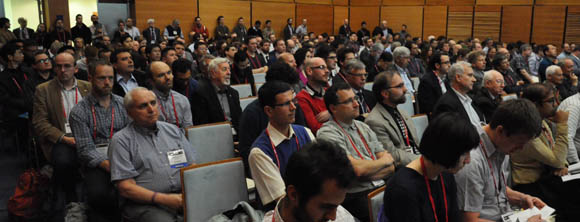
Support for photonic technologies in the Czech Republic
At the start of the meeting, Dr. Jan Šafanda, Vice-President of the Czech Academy of Sciences, welcomed the participants, saying: “I would like to express my gratitude to the organizers for convening such a large and representative scientific gathering in Prague and for including outstanding scientists from two institutes of the Academy of Sciences, namely the Institute of Photonics and Electronics and the Institute of Physics, among its chairpersons and steering committee members. Looking at the list of topics discussed during the symposium, I realized how much potential this field of science has. The Czech Academy of Sciences strongly supports research in this area of physics. As you probably know, two large laser research centers have been built near Prague in Dolní Břežany under the leadership of the Institute of Physics. One of the centers is HiLASE, which stands for high average power pulsed lasers, and the other is Extreme Light Infrastructure, or ELI Beamlines. We all believe that both facilities will be among the leading European scientific centers, attracting top scientists and providing them with excellent conditions for cutting-edge research.”
Interdisciplinary approach to light research and applications
Since 2007, the SPIE Optics + Optoelectronics symposium has been held every two years in Prague, alternating with the SPIE Photonics Europe symposium in Brussels, which is also held every two years. The Prague symposium included 16 technical conferences and a Laser Energy workshop focused on laser inertial fusion research. Participants and speakers came from countries across Europe, Russia, China, the USA, Japan, Korea, and China. Mutually complementary topics promoted synergy between the individual conferences. The sub-conferences focused on laser particle accelerators and their medical applications, optical sensors, special optical fibers, high-energy and high-pulse-intensity laser technologies, integrated optics, holography, optical metamaterials, quantum optical information transfer, and other topics. Several major international projects were represented at the meeting, making the symposium an important venue where researchers, representatives of government research funding agencies, and research infrastructure operators could discuss the current state of affairs, achievements, and new challenges.
Inspiration from exceptional figures in photonics
The plenary lectures were a major attraction for participants. Peter Moulton, inventor of the titanium-sapphire tunable laser, which brought revolutionary changes to the field of ultra-short pulse lasers in the 1980s, compared three main approaches to optical amplifiers with ultra-high peak pulse power: amplifiers based on bulk elements, parametric amplification of pumped pulses, and fiber amplifiers. His perspective as a practical experimenter who understands the seriousness of the physical and engineering problems involved in implementing devices with extreme peak pulse power was invaluable. The packed hall also listened to lectures by Ferenc Krausz from the Max Planck Institute for Quantum Optics in Munich on the possibilities of observing processes in atoms and molecules using attosecond lasers, and Andrea Melloni from the Milan Polytechnic on integrated photonic circuits. Sang-Hyun Oh from the University of Minnesota gave a plenary lecture on metal nanostructures for plasmonics and optoelectronics.
Lively discussions took place during the poster session and at the two-day exhibition, where nearly 30 manufacturers and suppliers showcased optical instruments, equipment, and components for industrial and research applications. There is much more that could be written about the symposium than can be covered in this limited space. Additional images from the event can be found on the back cover. A more detailed report will be published in the near future in the Czechoslovak Journal of Physics, and detailed and readable reports are also available directly on the SPIE website www.spie.org/eoo.
